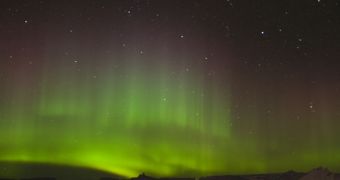According to astronomers, amateur skywatchers training their telescopes on the night sky on Monday or Tuesday (August 9-10) could see beautiful and luminous aurora lights. Over the weekend, a new solar flare was produced on the Sun, and its shock wave has already begun slamming into our planet's protective layer, the magnetosphere. The lights will be mostly visible from the Northern Hemisphere, solar physicists say, quoted by Space.
The new solar flare was observed on Saturday, August 7, and experts couldn't help noticing that it took place precisely one week after the August 1 one, which also caused wonderful aurora displays. Readings of the new solar event show that it was even stronger than last week's flare. But the effects on the magnetosphere may be more reduced in intensity, due to the fact that the emission was not oriented directly towards us, experts say. The August 1 event was assigned to C-class status due to its dominant characteristics, and the properties of the X-ray radiation it emitted, solar physicists reveal.
The August 7 event was now classified as an M-class event, which means it enters the second most-intense category of solar flares, after X-class. “I saw them [the Northern Lights] as soon as the Sun went down, and as I kept watching, the structure and the color turned completely mind-blowing. It never gets old watching them dancing with vibrant green color and also sometimes blue and red glow mixed with it,” tells Space in an e-mail amateur skywatcher Gunjan Sinha, who is based in Saskatchewan, Canada.
“The actual experience itself was terrific. It was a wonderful show the other night, and I'm glad that it wasn't clouded over like has been the case for much of the night-sky events this year,” adds Colin Chatfield, who is based in the same Canadian city. NASA's most advanced dedicated telescope, the Solar Dynamics Observatory (SDO), managed to snap a photo of the Sun as it was erupting. The image shows the star in extreme ultraviolet (EUV) wavelengths, where most variations are visible on its surface.

 14 DAY TRIAL //
14 DAY TRIAL //